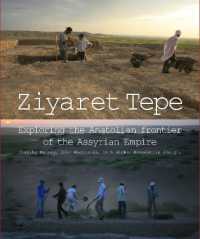- ホーム
- > 洋書
- > 英文書
- > Science / Mathematics
Full Description
Small Area Estimation and Microsimulation Modeling is the first practical handbook that comprehensively presents modern statistical SAE methods in the framework of ultramodern spatial microsimulation modeling while providing the novel approach of creating synthetic spatial microdata. Along with describing the necessary theories and their advantages and limitations, the authors illustrate the practical application of the techniques to a large number of substantive problems, including how to build up models, organize and link data, create synthetic microdata, conduct analyses, yield informative tables and graphs, and evaluate how the findings effectively support the decision making processes in government and non-government organizations.
Features
Covers both theoretical and applied aspects for real-world comparative research and regional statistics production
Thoroughly explains how microsimulation modeling technology can be constructed using available datasets for reliable small area statistics
Provides SAS codes that allow readers to utilize these latest technologies in their own work.
This book is designed for advanced graduate students, academics, professionals and applied practitioners who are generally interested in small area estimation and/or microsimulation modeling and dealing with vital issues in social and behavioural sciences, applied economics and policy analysis, government and/or social statistics, health sciences, business, psychology, environmental and agriculture modeling, computational statistics and data simulation, spatial statistics, transport and urban planning, and geospatial modeling.
Contents
Table of Contents
Preface
Introduction
Introduction
Main Aims of the Book
Guide for the Reader
Concluding Remarks
Small Area Estimation
Introduction
Small area estimation
Advantages of small area estimation
Why small area estimation techniques?
Applications of small area estimation
Approaches to small area estimation
Direct estimation
Horvitz-Thomposn (H-T) estimator
Generalized regression (GREG) estimator
Modified direct estimator
Design-based model-assited estimators
A comparison of direct estimators
Concluding remarks
Indirect Estimation: Statistical Approaches
Introduction
Implicit models approach
Synthetic estimaton
Composite estimation
Demographic estimation
Comparison of various implicit models based indirect estimation
Explicit models approach
Basic area level model
Basic unit leve model
General linear mixed model
Comparison of various explicit models based indirect estimation
Methods for estimating explicit models
E-BLUP approach
EB approach
HB approach
A comparison of three methods
Concluding remarks
Indirect Estimation: Geographic Approaches
Introduction
Microsimulation modeling
Process of microsimulation
Types of microsimulation models
Advantages of microsimulation modeling
Methodologies in microsimulation modeling technology
Techniques for creating spatial microdata
Statistical data matching or fusion
Iterative proportional fitting
Repeated weighting method
Reweighting
Combinatorial optimisation reweighing approach
The simulated annealing method in CO
An illustration of CO process for hypothetical data
Reweighting: The GREGWT approach
Theoretical setting
How does GREGWT generate new weights?
Explicit numerical solution for a hypothetical data
A comparison between GREGWT and CO
Concluding remarks
Bayesian Prediction-Based Microdata Simulation
Introduction
The basic steps
The Bayesian prediction theory
The multivariate model
The prior and posterior distributions
The linkage model
Prediction for moedling unobserved population units
Concluding remarks
Microsimulation Modelling Technology for Small Area Estimation
Introduction
Data sources and issues
The Census Data
Survey Datasets
Survey Datasets
MMT based Model Specification
Model inputs
Generating small area synthetic weights
Model inputs
Generating small area synthetic weights
Model inputs
Gnerating small area synthetic weights
Model outputs
Housing stress
Definition
Measures of housing stress
A comparison of various measures
Small area estimation of housing stress
Inputs at the second stae model
Final model outputs
Concluding remarks
Applications of the Methodologies
Introduction
Results of the model: A general view
Model accuracy report
Scenarios of housing stress under various measures
Distribution of housing stress estimation
Lorenz curve for housing stress estimates
Proportional cumulative frequency graph and index of dissimilarity
Scenarios of households and housing stress by tenures
Estimation of households in housing stress by spatial scales
Results for different states
Results for various statistical divisions
Results for various statistical subdivisions
Small area estimates: Number of households in housing stress
Estimated numbers of overall households in housing stress
Estimated numbers of buyerhouseholds in housing stress
Estimated numbers of public renter households in housing stress
Estimated numbers of private renter households in housing stress
Estimated numbers of total renter households in housing stress
Small area estimates: Percentage of households in housing stress
Percentage estimates of housing stress for overall households
Percentage estimates of housing stress for buyer households
Percentage estimates of housing stress for public renter households
Percentage estimates of housing stress for private renter households
Percentage estimates of housing stress for total renter households
Concluding remarks
Analysis of Small Area Estimates in Capital Cities
Introduction
Scenarios of the results for major capital cities
Trends in housing stress for some major cities
Mapping the estimates at SLA levels within major cities
Sydney
Housing stress estimates for overall households
Small area estimation by household's tenure types
Melbourne
Housing stress estimates for overall households
Small area estimation by household's tenure types
Brisbane
Housing stress estimates for overall households
Small area estimation by household's tenure types
Adelaide
Housing stress estimates for overall households
Small area estimation by household's tenure types
Canberra
Housing stress estimates for overall households
Small area estimation by household's tenure types
Hobart
Housing stress estimates for overall households
Small area estimation by household's tenure types
Darwin
Housing stress estimates for overall households
Small area estimation by household's tenure types
Concluding remarks
Validation and Measure of Statistical Reliability
Introduction
Some validation methods in the literature
New approaches to validating housing stress estimation
Statistical significance test of the MMT estimates
Results of the statistical significance test
Absolute standardised residual estimate (ASRE) analysis
Results from the ASRE analysis
Measure of statistical reliability of the MMT estimates
Confidence interval estimation
Results from the estimates of confidence intervals
Concluding remarks
Conclusions and Computing Codes
Introduction
Summary of major findings
Limitations
Areas of further studies
Computing codes and programming
The general model file codes
SAS programming for reweithing algorithms
The second stage program file codes
Concluding remarks
Appendices.








